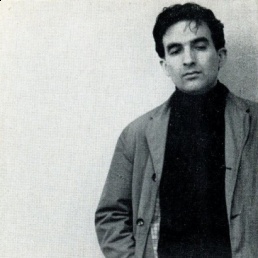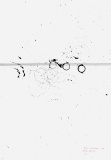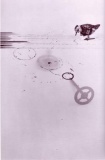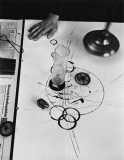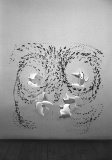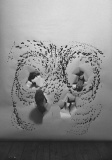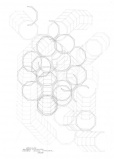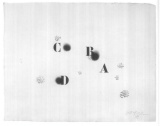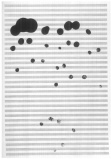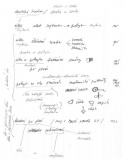Difference between revisions of "Milan Grygar"
(→Links) |
|||
| (23 intermediate revisions by the same user not shown) | |||
| Line 1: | Line 1: | ||
| − | Milan Grygar was born in Zvolen, Slovakia in 1926. After graduating from the College of Applied Arts, [[Prague]] (where he studied under Professor Emil Filla) he concentrated on still lifes which evolved into colour compositions devoid of subject matter. In 1964 | + | {{Infobox artist |
| + | |image = Milan-Grygar.jpg | ||
| + | |imagesize = 250px | ||
| + | |caption = A portrait from the artist's archive. | ||
| + | |birth_date = {{birth date|1926|10|24|mf=y}} | ||
| + | |birth_place = Zvolen, Czechoslovakia | ||
| + | }} | ||
| + | [[Image:Milan_Grygar.jpg|thumb|258px|]] | ||
| + | [[Image:Milan_Grygar_photo_Miroslav_Jodas.jpg|thumb|258px|Photo by Miroslav Jodas]] | ||
| + | Czechoslovak audiovisual artist, painter, and typographer. Milan Grygar was born in Zvolen, Slovakia in 1926. After graduating from the College of Applied Arts, [[Prague]] (where he studied under Professor Emil Filla) he concentrated on still lifes which evolved into colour compositions devoid of subject matter. In 1964 he produced a series of 64 black-and-white drawings using the principle of a linear sequence. Working in a fast rhythm, he could "hear" the drawing he was creating. From there, it was only a step to a discovery that was to define his future artistic career and bring him recognition. Grygar began tape recording the acoustic process of drawing. In 1965 he started to pursue the relationship between drawing and sound, and in 1966 exhibited his first acoustic drawings with accompanying tape recordings. These New Drawings led him to the direction known as the New Music, and were followed by large drawings and paintings recording hand movements. The next stage concerned mechanic-acoustic drawings in which Grygar employed resounding mechanisms as drawing tools. A new comprehensive series entitled ''Ground-Plan Scores'' [Půdorysné partitury] started to take shape in 1967. In the series, drawings are composed as projections of "spread" sounds. | ||
| − | Similar performances took place in [[Brno]] (1968; 1973, including Homage to Magic), [[ | + | In 1970, Grygar held a performance called ''Audiovisual Relations'' [Audiovizuální vztahy] in the Ales Hall, Prague, in the course of which he executed an acoustic drawing as well as a unique haptic drawing, which he entered as a material being producing a drawing with his fingers, without the supervision of sight. Similar performances took place in [[Brno]] (1968; 1973, including ''Homage to Magic''), at the Museum of Art in [[Łódź]] (at Ryszard Stanisławski's invitation, 1974), Prague (1985), at a festival in [[Ghent]] (1986), and in [[Warsaw]] (2010) [http://www.galeriafoksal.pl/old/kod/grygar/wyst.htm]. The artist renders all his drawings and paintings as scores based on different principles (e.g. colour scores in which he sets a precise list of musicians and sound sources, architectural, 12 horizons etc.). Another spur for a sound interpretation was provided by sound-relief drawings which Grygar explored from 1972. In 1976, this system of a rhythmical square grid gave way to the linear principle in drawings which can be also interpreted acoustically. Large-format drawings referred to as spatial scores are offset by ''White Images'' [Bílé obrazy] (1980). |
| − | In 1986 Milan Grygar participated in the Chambres d'Amis international event in | + | Grygar His collaboration with a musical theorist [[Vladimír Lébl]] gave a way to an exhibition for the [[International_Seminars_on_New_Music,_Smolenice|festival of experimental music at Smolenice]] in 1970. His ''Architectonic Score'' (1970) was realized by the [[Erhard Karkoschka]]'s group from Stuttgart in 1973 (Theater der Altstadt, Stuttgart) and 1983 (3. Stuttgarter Sommerkurse), other scores by [[Agon Orchestra]], [[Jean-Yves Bosseur]], or [[MoEns]] group from Prague. |
| + | |||
| + | In 1986 Milan Grygar participated in the Chambres d'Amis international event in Ghent. The last phase of his work is associated with ''Black Images'' [Černé obrazy] on the principle of black planes and colour lines in which the key part is played by fixed light. Milan Grygar's acoustic drawings were published by Supraphon on two LP's in 1969 and 1976. | ||
| + | == Works== | ||
| + | ; Acoustic Drawings | ||
| + | <gallery> | ||
| + | File:Grygar_Milan_1965_Acoustic_Drawing.jpg|1965 | ||
| + | File:Grygar Milan 1967 Acoustic Drawing Aa.jpg|''Acoustic Drawing Aa'', 1967 | ||
| + | File:Grygar_Milan_1967_Acoustic_Drawing.jpg|''Acoustic Drawing Ad'', 1967 | ||
| + | File:Grygar Milan 1967 Acoustic Drawing 5.jpg|1967 | ||
| + | File:Grygar_Milan_1968_Acoustic_Drawing_A18.jpg|''A18'' | ||
| + | File:Grygar_Milan_1986_Acoustic_Drawing.jpg|1986 | ||
| + | </gallery> | ||
| − | + | ; Tactile Drawing, performance, 1969 | |
| + | <gallery> | ||
| + | File:Grygar_Milan_1969_Tactile_Drawing_1.jpg|Photo by Josef Prošek | ||
| + | File:Grygar_Milan_1969_Tactile_Drawing_2.jpg|Photo by Josef Prošek | ||
| + | File:Grygar_Milan_1969_Tactile_Drawing_3.jpg|Photo by Josef Prošek | ||
| + | File:Grygar_Milan_1969_Tactile_Drawing_4.jpg|Photo by Josef Prošek | ||
| + | File:Grygar_Milan_1969_Haptic_Drawing_2.jpg|1969 | ||
| + | File:Grygar_Milan_1969_Haptic_Drawing.jpg|1969 | ||
| + | </gallery> | ||
| + | | ||
| + | ; Ground-Plan Score | ||
| + | <gallery> | ||
| + | File:Grygar Milan 1968 Ground-Plan Score Formula.jpg|''Ground-Plan Score + Formula'', 1968 | ||
| + | File:Grygar Milan 1968 Ground-Plan Score with Objects.jpg|''Ground-Plan Score with Objects'', 1968 | ||
| + | File:Grygar Milan 1968 Ground-Plan Score for Five Large and One Small Ariston.jpg|''Ground-Plan Score for Five Large and One Small Ariston'', 1968 | ||
| + | File:Grygar Milan 1968 Ground-Plan Score realisation.jpg|''Ground-Plan Score, realisation'', 1968 | ||
| + | </gallery> | ||
| + | ; Other scores | ||
| + | <gallery> | ||
| + | File:Grygar Milan pre-1970 Calligraphic Score.jpg|''Calligraphic Score'', pre-1970 | ||
| + | File:Grygar Milan 1969 80 Optical Records of a Sound of the Screws.jpg|''80 Optical Records of a Sound of the Screws'', 1969 | ||
| + | File:Grygar Milan 1969 Score Sound Layers Project.jpg|''Score - Sound Layers Project'', 1969 | ||
| + | File:Grygar Milan 1970 Architectonic Score.jpg|''Architectonic Score'', 1970 | ||
| + | File:Grygar Milan 1970 Architectonic Score 2.jpg|''Architectonic Score'', 1970 | ||
| + | File:Grygar Milan 1971 CBDA Land Score.jpg|''CBDA Land Score'', 1971 | ||
| + | File:Grygar Milan 1972 Blue Score.jpg|''Blue Score'', 1972 | ||
| + | File:Grygar Milan 1972 Finger Score.jpg|''Finger Score'', 1972 | ||
| + | File:Grygar Milan 1981 Linear Score.jpg|''Linear Score'', 1981 | ||
| + | </gallery> | ||
| − | + | ; Notes | |
| + | <gallery> | ||
| + | File:Grygar Milan text excerpt.jpg | ||
| + | </gallery> | ||
| − | ; Publications | + | ; Sound releases |
| + | * ''Acoustic Drawing 22 / Adagio'', Supraphon, 399861, 1969. [http://soundcloud.com/pauldavidkahn/montaz-akusticke-kresby-1969] | ||
| + | * Milan Grygar, ''Kresba 18 A 17'', Supraphon, 1 49 9871, 1976. [http://www.discogs.com/Milan-Grygar-Kresba-18-A-17/release/2591292] | ||
| + | |||
| + | ; Films and documentation | ||
| + | * ''Akustická kresba'' [Acoustic Drawing], dir. Ľudovít Vavro, 1968 | ||
| + | * ''Černobílé kontrapunkty'', 35 mm, dir. Josef and Jaroslav Kořán, 1971 | ||
| + | * ''Prstová partitura'', 16 mm, dir. Dobroslav Zborník, 1982 | ||
| + | * ''Hmatová kresba'' [Haptic Drawing], 16 mm, dir. Dobroslav Zborník, 1983 | ||
| + | * ''Akustické realizace a hmatová kresba'', dir. Alexandre Broniarski, Bruno Laurin, 1993 | ||
| + | |||
| + | == Publications== | ||
| + | ; Books and catalogues | ||
| + | * Mojmír Grygar, Jaromír Paclt, ''Milan Grygar: nová kresba'', Prague: Galerie bratří Čapků, 1966. | ||
| + | * Jiří Valoch, Jan Sekera, ''Milan Grygar'', catalogue, Prague: Středočeská galerie, 1991. | ||
| + | * Jozef Cseres, ''Milan Grygar: Akustické kresby a partitúry'', catalogue, Nové zámky 1992. | ||
| + | * Hana Larvová, ''John Cage, François Morellet, Milan Grygar: Otevřená forma'', catalogue, Dům U kamenného zvonu 1993-1994. | ||
| + | * Jiří Zemánek, ''Milan Grygar: Obraz a zvuk'', catalogue,, Prague: National Gallery, 1997. | ||
| + | * Milan Grygar, ''Obraz a Zvuk / Image and Sound'', catalogue, Collection of Modern and Contemporary Art in Prague, with Gema Art, 1999. | ||
| + | * Josef Hlaváček, ''Milan Grygar: Obraz a barva'', catalogue, Litoměřice: Severočeská galerie výtvarného umění, 2001. | ||
| + | * ''Milan Grygar / akustické kresby a partitury'', with audio CD, Zdeněk Sklenář Gallery, 2006. | ||
| + | * ''Monografie Milan Grygar'', Gema Gallery, 2009. | ||
| + | * Hana Larvová, ''Milan Grygar'', catalogue, Prague, 2009. | ||
| + | * [[Media:Grygar_Milan_Lovec_hadu_catalogue.pdf|''Lovec hadů: Milan Grygar, 1961-1989'']], Prague: Terryho ponožky, 2013. [http://www.terry-posters.com/vystavni-cinnost/38-zlata-era-ceskoslovenskeho-filmoveho-plakatu--vii--milan-grygar Previous exhibition (2009)] | ||
| + | |||
| + | ; Articles | ||
| + | * Mojmír Grygar, "Jak se čte kresba", manuscript, 1996-1999. | ||
| + | * Florent Fajole, [http://www.new-mag.com/pdf/fajole-grygar.pdf "Garder le silence / Keeping the Silence"], ''new!'' 3, 2007. (French/English) | ||
* [http://www.electronicbeats.net/2012/09/09/hans-ulrich-obrist-interviews-milan-grygar/ "Interview: Hans Ulrich Obrist speaks to Milan Grygar"], ''Electronic Beats'', September 2012. | * [http://www.electronicbeats.net/2012/09/09/hans-ulrich-obrist-interviews-milan-grygar/ "Interview: Hans Ulrich Obrist speaks to Milan Grygar"], ''Electronic Beats'', September 2012. | ||
| − | ; See also | + | ; Theses |
| + | * Jana Matulová, [http://is.muni.cz/th/167250/ff_m/ ''Mezi obrazem a zvukem / Grafické partitury a jejich význam v současném audiovizuálním umění''], Master thesis, Brno: Masaryk University, 2012. (Czech) | ||
| + | * Šárka Masopustová, [http://is.muni.cz/th/262455/ff_m/ "Tvorba Milana Grygara v intermediálním kontextu"], Master thesis, Brno: Masaryk University, 2012. (Czech) | ||
| + | |||
| + | == See also== | ||
[[Czech_Republic#Electroacoustic_and_experimental_music.2C_sound_art]] | [[Czech_Republic#Electroacoustic_and_experimental_music.2C_sound_art]] | ||
| − | [[Category:Electroacoustic music | + | ==Links== |
| + | * [http://artlist.cz/?id=2554&lang=1 Grygar at Artlist] | ||
| + | * [http://abart-full.artarchiv.cz/osoby.php?i=3&Fprijmeni=Grygar Grygar at abART] | ||
| + | * [http://www.terry-posters.com/plakaty/parametr-1-autori/16-grygar-milan Grygar's posters and book covers at Terry-Posters.com] | ||
| + | * [http://zkm.de/event/2016/07/milan-grygar-sound-on-paper Exhibition at ZKM], Karlsruhe, 2016. | ||
| + | |||
| + | {{featured article}} | ||
| + | {{DEFAULTSORT:Grygar, Milan}} [[Category:Electroacoustic music]] [[Category:Sound art]] | ||
Revision as of 12:31, 31 December 2016
 A portrait from the artist's archive. | |
| Born |
October 24, 1926 Zvolen, Czechoslovakia |
|---|---|
Czechoslovak audiovisual artist, painter, and typographer. Milan Grygar was born in Zvolen, Slovakia in 1926. After graduating from the College of Applied Arts, Prague (where he studied under Professor Emil Filla) he concentrated on still lifes which evolved into colour compositions devoid of subject matter. In 1964 he produced a series of 64 black-and-white drawings using the principle of a linear sequence. Working in a fast rhythm, he could "hear" the drawing he was creating. From there, it was only a step to a discovery that was to define his future artistic career and bring him recognition. Grygar began tape recording the acoustic process of drawing. In 1965 he started to pursue the relationship between drawing and sound, and in 1966 exhibited his first acoustic drawings with accompanying tape recordings. These New Drawings led him to the direction known as the New Music, and were followed by large drawings and paintings recording hand movements. The next stage concerned mechanic-acoustic drawings in which Grygar employed resounding mechanisms as drawing tools. A new comprehensive series entitled Ground-Plan Scores [Půdorysné partitury] started to take shape in 1967. In the series, drawings are composed as projections of "spread" sounds.
In 1970, Grygar held a performance called Audiovisual Relations [Audiovizuální vztahy] in the Ales Hall, Prague, in the course of which he executed an acoustic drawing as well as a unique haptic drawing, which he entered as a material being producing a drawing with his fingers, without the supervision of sight. Similar performances took place in Brno (1968; 1973, including Homage to Magic), at the Museum of Art in Łódź (at Ryszard Stanisławski's invitation, 1974), Prague (1985), at a festival in Ghent (1986), and in Warsaw (2010) [1]. The artist renders all his drawings and paintings as scores based on different principles (e.g. colour scores in which he sets a precise list of musicians and sound sources, architectural, 12 horizons etc.). Another spur for a sound interpretation was provided by sound-relief drawings which Grygar explored from 1972. In 1976, this system of a rhythmical square grid gave way to the linear principle in drawings which can be also interpreted acoustically. Large-format drawings referred to as spatial scores are offset by White Images [Bílé obrazy] (1980).
Grygar His collaboration with a musical theorist Vladimír Lébl gave a way to an exhibition for the festival of experimental music at Smolenice in 1970. His Architectonic Score (1970) was realized by the Erhard Karkoschka's group from Stuttgart in 1973 (Theater der Altstadt, Stuttgart) and 1983 (3. Stuttgarter Sommerkurse), other scores by Agon Orchestra, Jean-Yves Bosseur, or MoEns group from Prague.
In 1986 Milan Grygar participated in the Chambres d'Amis international event in Ghent. The last phase of his work is associated with Black Images [Černé obrazy] on the principle of black planes and colour lines in which the key part is played by fixed light. Milan Grygar's acoustic drawings were published by Supraphon on two LP's in 1969 and 1976.
Contents
Works
- Acoustic Drawings
- Tactile Drawing, performance, 1969
- Ground-Plan Score
- Other scores
- Notes
- Sound releases
- Acoustic Drawing 22 / Adagio, Supraphon, 399861, 1969. [2]
- Milan Grygar, Kresba 18 A 17, Supraphon, 1 49 9871, 1976. [3]
- Films and documentation
- Akustická kresba [Acoustic Drawing], dir. Ľudovít Vavro, 1968
- Černobílé kontrapunkty, 35 mm, dir. Josef and Jaroslav Kořán, 1971
- Prstová partitura, 16 mm, dir. Dobroslav Zborník, 1982
- Hmatová kresba [Haptic Drawing], 16 mm, dir. Dobroslav Zborník, 1983
- Akustické realizace a hmatová kresba, dir. Alexandre Broniarski, Bruno Laurin, 1993
Publications
- Books and catalogues
- Mojmír Grygar, Jaromír Paclt, Milan Grygar: nová kresba, Prague: Galerie bratří Čapků, 1966.
- Jiří Valoch, Jan Sekera, Milan Grygar, catalogue, Prague: Středočeská galerie, 1991.
- Jozef Cseres, Milan Grygar: Akustické kresby a partitúry, catalogue, Nové zámky 1992.
- Hana Larvová, John Cage, François Morellet, Milan Grygar: Otevřená forma, catalogue, Dům U kamenného zvonu 1993-1994.
- Jiří Zemánek, Milan Grygar: Obraz a zvuk, catalogue,, Prague: National Gallery, 1997.
- Milan Grygar, Obraz a Zvuk / Image and Sound, catalogue, Collection of Modern and Contemporary Art in Prague, with Gema Art, 1999.
- Josef Hlaváček, Milan Grygar: Obraz a barva, catalogue, Litoměřice: Severočeská galerie výtvarného umění, 2001.
- Milan Grygar / akustické kresby a partitury, with audio CD, Zdeněk Sklenář Gallery, 2006.
- Monografie Milan Grygar, Gema Gallery, 2009.
- Hana Larvová, Milan Grygar, catalogue, Prague, 2009.
- Lovec hadů: Milan Grygar, 1961-1989, Prague: Terryho ponožky, 2013. Previous exhibition (2009)
- Articles
- Mojmír Grygar, "Jak se čte kresba", manuscript, 1996-1999.
- Florent Fajole, "Garder le silence / Keeping the Silence", new! 3, 2007. (French/English)
- "Interview: Hans Ulrich Obrist speaks to Milan Grygar", Electronic Beats, September 2012.
- Theses
- Jana Matulová, Mezi obrazem a zvukem / Grafické partitury a jejich význam v současném audiovizuálním umění, Master thesis, Brno: Masaryk University, 2012. (Czech)
- Šárka Masopustová, "Tvorba Milana Grygara v intermediálním kontextu", Master thesis, Brno: Masaryk University, 2012. (Czech)
See also
Czech_Republic#Electroacoustic_and_experimental_music.2C_sound_art
